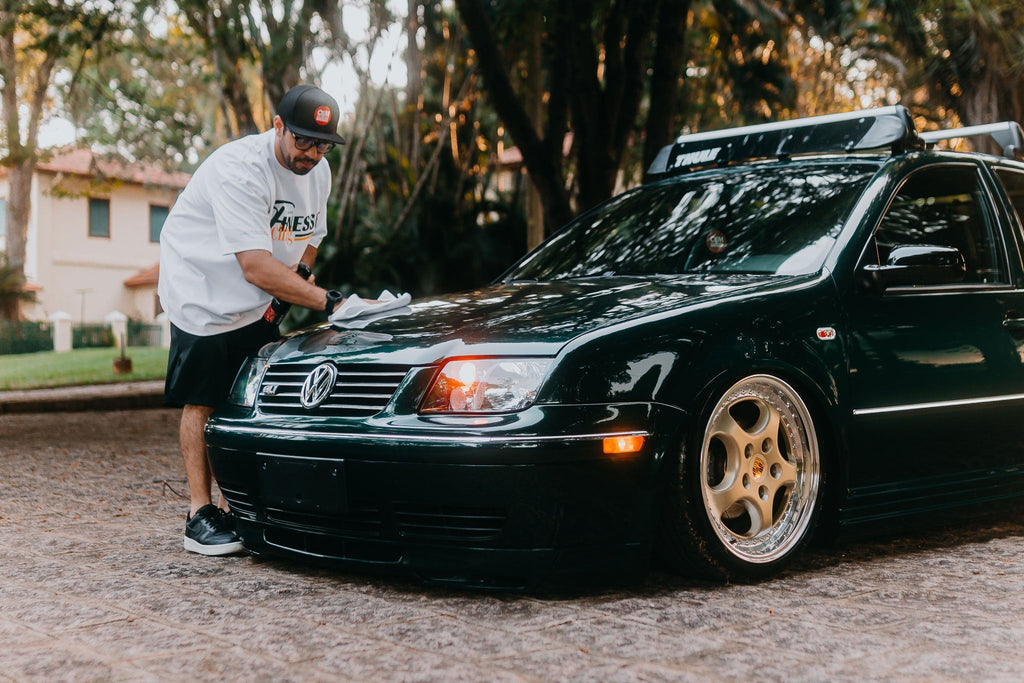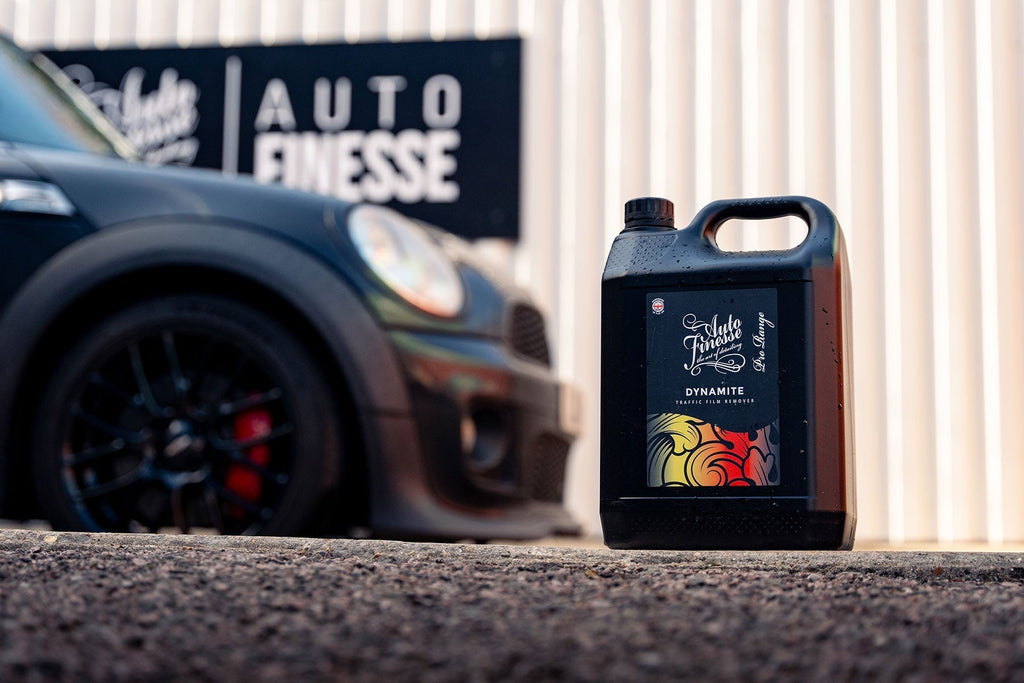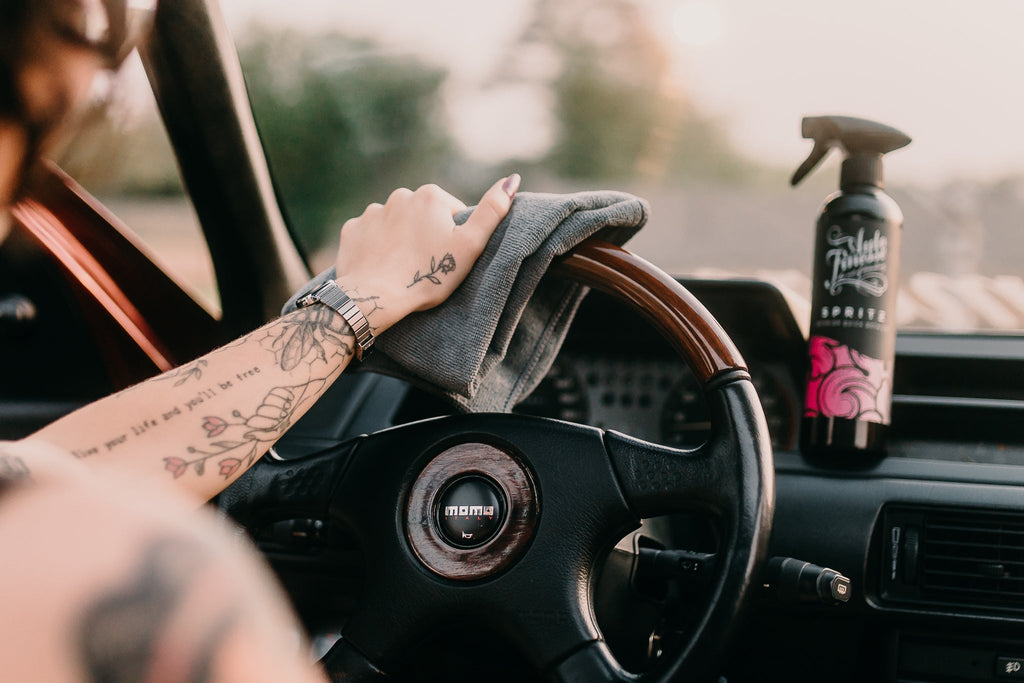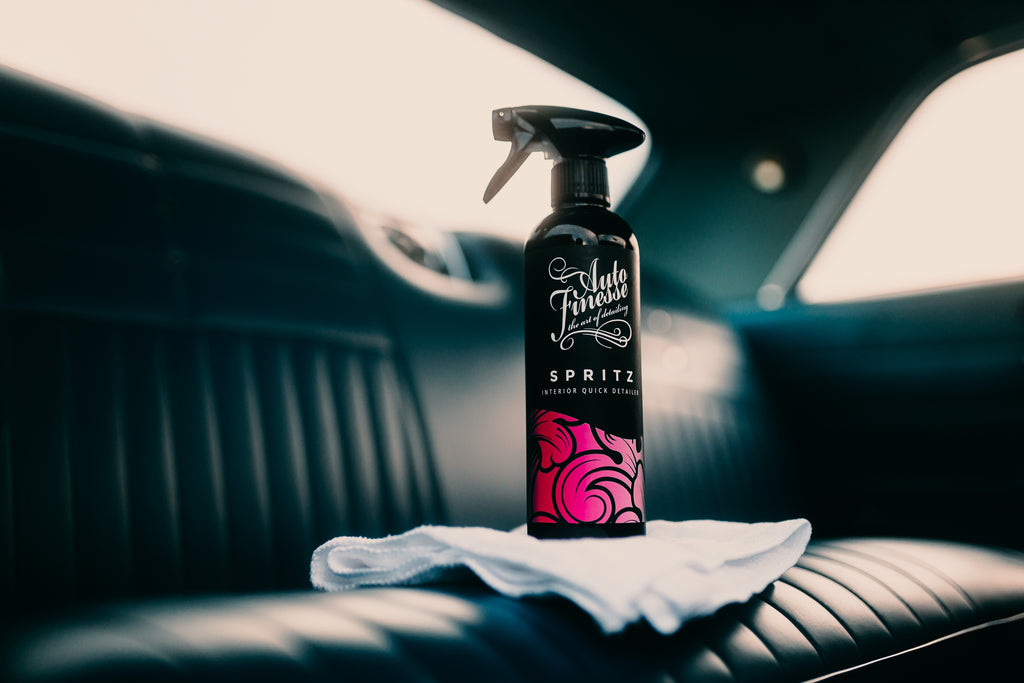Which Microfibre Towel Should I Use?

In This Guide You Will:
- Understand the various types of microfibre cloth construction and see how making the right choice will get the best results.
- Explore how microfibre works and the best detailing products to use with your cloths.
- Learn how weight and weave influence the ideal cloth for different tasks and see how to make your cloths last longer.
Get The Best Possible Results By Choosing The Right Cloth For The Job...
Microfibre cloths and towels are not just a detailer's best friend—they’re an essential tool for nearly every cleaning and finishing task. But how well do you really know yours? The truth is, not all microfibre cloths are created equal.
There’s a wide range of microfibre towels available, each with specific attributes tailored to different tasks and different detailing products. Whether you’re cleaning, polishing, or finishing, using a cloth designed for the job at hand will always deliver the best results. Beyond that, choosing high-quality cloths is vital to avoid damage, enhance performance, and ensure durability, helping to keep costs down in the long run.

Microfibre cloths make all the difference when it comes to using detailing products to detail and valet your car. we all know that cloths are a detailer’s best friend – after all,...
What Exactly Is Microfibre?
In detailing, we often use the term "microfibre" to describe an entire towel, but it actually refers to the individual fibres themselves. To qualify as a microfibre, each fibre must be finer than 1 denier, approximately the diameter of a single strand of silk. The microfibres used in automotive cloths typically range from 0.1 to 0.3 denier, making them up to 200 times finer than a human hair. These fibres are made from a synthetic blend of polyester, which forms the primary structure, and polyamide (nylon), which enhances absorption and density. Common blends are 70:30 or 80:20 polyester to polyamide.
During manufacturing, the fibres are split to make them exceptionally fine and are woven into various constructions, such as closed loop, waffle, and twisted loop. These, along with short and deep pile designs, each offer unique attributes, making them ideal for specific detailing tasks.

How Do Microfibre Cloths Actually Clean & Dry A Car?
Microfibre cloths are not just versatile companions for a variety of detailing products; they also possess inherent cleaning and drying capabilities thanks to their unique split fibres, weight, and weave construction.
For instance, when you run a short-pile, closed-loop microfibre cloth (like our Work Cloths) over your hand, it might feel slightly "grippy." This sensation isn’t due to a lack of softness or a risk of scratching surfaces, but rather the fine fibres interacting with and clinging to tiny imperfections in your skin—imagine these fibres as countless tiny hooks. Similarly, these fibres excel at picking up and retaining dirt and moisture, rather than merely spreading them around.
The structure of the fibres themselves also plays a crucial role. A split microfibre strand has a cross-section resembling an asterisk ( * ) or a multi-spoke wheel face without the outer rim. This design dramatically increases the surface area, allowing the strands to capture fine particles within their structure. When dragged across wet or dry surfaces, these fibres effectively lift and trap particles or water molecules within individual strands. This property makes microfibre far superior to cotton for tasks like dry dusting an LCD screen. Cotton fibres have a round cross-section, which can trap some dirt between strands but lacks the ability to hold fine particles within the fibres themselves. Consequently, a microfibre cloth captures and holds dust, rather than simply redistributing it.
Additionally, the effectiveness of microfibre when dry dusting is enhanced by an intriguing scientific factor. During the fibre splitting process—which increases their fineness, absorbency, and surface area—the fibres gain a positive static charge. This charge attracts and securely holds negatively charged dust particles, making microfibre cloths an excellent choice for achieving a thorough and residue-free clean.

What Is GSM?
GSM, or grams per square metre, refers to the dry weight (or density) of a microfibre cloth. This figure is independent of the weave type or pile length, but generally, a higher GSM indicates a softer cloth that’s better suited for absorbing moisture or liquid detailing products. For example, our ultra-deep pile Aqua Deluxe Drying Towel is specifically designed for drying and boasts an impressive 1200GSM, enabling it to absorb significant amounts of water. High-GSM cloths are also ideal for sensitive surfaces, like soft paint. Our Ultra Plush Microfibre, with its thick, plush 800GSM, is not only highly absorbent but also perfect for buffing products and removing residues.
Lower GSM cloths are less absorbent but excel in heavier cleaning tasks. For automotive use, however, it’s best to avoid GSM ratings below 250. Our 300GSM Work Cloths strike a balance between softness and durability, making them versatile for a wide range of detailing tasks.
Another key aspect of cloth density is durability during washing. In theory, a higher GSM corresponds to increased resilience to wear and tear in the washing machine, reducing the likelihood of fraying or degrading. However, this difference is often minimal. High-quality microfibre cloths, regardless of GSM, can last for years—up to approximately 500 washes—with proper care.

How Does The Pattern Make A Difference?
The weave pattern plays a significant role in choosing the right microfibre cloth for a specific task.
- Short-Pile, Closed-Loop Cloths: These are ideal for deep cleaning and debris removal. They excel when used with liquid cleaning products and are perfect for removing residues left by polishes, waxes, or coatings. Our Work Cloths are a great example of short-pile closed-loop microfibre.
- Dense, Deep-Pile Cloths: Known for their softness and absorbency, these are best suited for tasks involving quick detailers, dry dusting sensitive surfaces, final buffing, and soaking up water. Our Primo Plush and Ultra Plush Microfibre Towels are deep-pile cloths.
- Twisted Loop Weaves: This design features ultra-deep pile fibres that are bundled together, compacted, and twisted into a long, spiral configuration. This increases the surface area dramatically, making these cloths excellent for maximum absorption. A great example of this is our Silk Drying Towel, which uses this design to deliver unparalleled drying performance.
- Waffle Weave Patterns: Patterns such as those found in our Superior Waffle and Glass Waffle cloths are also optimized for a large surface area, making them perfect for absorbing spray products. While all microfibre is designed to trap potentially harmful particles within its fibres, these weaves go further by incorporating physical "pockets" between the fibres. These pockets can store larger debris during cleaning. This reduces the risk of scratching.



How To Make My Microfibre Cloths Last Longer?
Proper care can extend the lifespan of your microfibre cloths significantly. High-quality microfibre cloths are generally safe for machine or hand washing at cool temperatures. The key is to avoid melting or damaging the synthetic fibres, which can make the cloths sharp, scratchy, and unusable. This is why we recommend washing at temperatures below 30°C and avoiding ironing or tumble drying at high heat.
Exceptions to the "Washable and Reusable" Rule
While most microfibre cloths can be reused after washing, there are exceptions:
- Ceramic Coating Residue: Cloths used to buff off ceramic coatings should be discarded, as residue can be nearly impossible to remove.
- Solvent-Based Products: Towels exposed to tar or glue removers often retain traces of solvents that may compromise future cleaning tasks.
- Heavily Contaminated Cloths: Cloths that are extremely dirty or have been dropped on the floor should also be replaced, as trapped particles can cause scratches during the next use.
Avoiding Fabric Softeners
Fabric softeners should never be used when washing microfibre. These products leave a coating on the fibres, reducing their ability to clean, absorb, and trap particles effectively.
Detergents: What to Use and Avoid
- Avoid Powdered Detergents: These can leave behind undissolved particles that are abrasive and can scratch sensitive surfaces.
- Use Liquid Detergents: Specifically, we recommend using Micro Wash, a liquid detergent designed to remove grime and detailing product residues while conditioning the fibres. Use approximately 50ml per wash for hand or machine washing at a low temperature.
Drying and Storing
After washing, spin-dry at a high setting to remove excess water, then hang your cloths to air dry. Once completely dry, fold and store them in a clean, dust-free environment for future use.
Preventing Cross-Contamination
To avoid cross-contamination:
- Separate by Pile Length: Wash short-pile and long-pile cloths separately.
- Wash Drying Towels Alone: Drying Towels should be washed separately since they typically haven’t come into contact with cleaning products or heavy residues.
By following these care guidelines, your microfibre cloths can remain effective and durable for years to come.
For more on how to keep your cloths in the best condition, see our full article: Washing Your Microfibre Cloths.

The AF Microfibre Cloth Range
We offer a machine-washable microfibre cloth for every task, carefully designed to help you tackle all your cleaning, polishing, and finishing needs. Here’s a quick guide to our range of cloths and their specific purposes…


Microfibre Work Cloths
Measuring 400x400mm, these cloths are the ultimate all-rounders in our range, capable of handling a variety of detailing tasks with ease. Our short-pile, 300GSM closed-loop microfibre Work Cloths feature machine-stitched edges for added durability, making them perfect for repeated use, even on tougher jobs.
We often rely on these cloths as versatile, multi-purpose tools, especially during the cleaning and polishing stages. They're perfect for heavy-duty tasks like cleaning engine bays and interiors, and removing polish, wax or ceramic coating residues. Pairing a Work Cloth with a bottle of Tripple All-in-One Polish can also be a powerful combo for tackling hard-to-reach areas, such as door jambs, engine parts, boot shuts, and behind door handles.
Our white Work Cloths are available in a pack of three. Our Work Cloth Trio includes teal, grey and white cloths (ideal for dedicated detailing processes), and in our Premium Cloth Box, contains 12 white and 12 grey Work Cloths. There's also our Disposable Cloth Box which contains 50 teal/white cloths, without the machine stitched edging.

Primo Plush Cloth
The Primo Plush is the ideal professional finisher—an extra-large 600x400mm towel with a super-deep, fluffy pile. Designed for final buffing, it boasts exceptional absorbency, making it perfect for use with Finale Quick Detailer and Glisten Spray Wax. Made from soft 600GSM microfibre with a non-scratch micro-suede edging, the Primo Plush is gentle on all sensitive surfaces. It’s also great for dry dusting, removing wax residues, or mopping up water drips.






The Auto Finesse® Primo Plush cloth has a deep fluffy pile both sides, with black micro-suede edging for scratch-less detailing, perfect for quick detailing tas... See product details More

Ultra Plush Cloth
The Ultra Plush microfibre towel is incredibly soft, with an ultra-deep 800GSM pile. Measuring 400x400mm, this premium cloth offers exceptional absorbency, making it perfect for tasks like mopping up drips or drying intricate areas such as wheels and door shuts. It’s also highly effective for removing wax residue, final buffing spray waxes, and soaking up detailing sprays. Like the Primo Plush, the Ultra Plush features a non-scratch, micro-suede edging for added protection.






These ultra plush microfibre cloths are 800 GSM and perfect for use with our detailing sprays, and spray waxes, also residue left by our signature waxes. The d... See product details More

Superior Waffle Cloth
The 600x400mm Superior Waffle is one of our specially designed waffle weave glass cleaning towels, ideal for use with glass cleaners like Crystal Glass Cleaner . Soft and highly absorbent, the Superior Waffle efficiently absorbs liquids while lifting and trapping debris in its recessed pockets, keeping it away from the surface. It’s the ultimate towel for fast glass cleaning, delivering a streak-free finish every time.






Developed as the ultimate glass cleaning towel, the Superior Waffle is the ideal product for the fastest cleaning on all interior and exterior glass surfaces,... See product details More

Glass Waffle Cloth
The Glass Waffle is perfect for use with spray glass cleaners when a bit more scrubbing power is needed. Measuring 600x400mm, the Glass Waffle uses slightly stiffer microfibre than the Superior Waffle, providing extra scrubbing action for stain removal and rejuvenating tired glass. Despite its firmer texture, it remains absorbent and features a significantly larger surface area than traditional cloths, allowing it to trap polish residue and debris deep within its recesses.






The best glass cloth for deep-cleaning, polishing and restoring all glass surfaces, our revolutionary Glass Waffle microfibre has been developed by professiona... See product details More

Aqua Deluxe Drying Towel
The Aqua Deluxe is our original drying towel, crafted from an incredibly soft, 1200GSM plush microfibre that can absorb an impressive amount of water. Designed specifically for safe and effortless drying, it features a highly absorbent inner core and non-scratch edging for added durability. Measuring 500x700mm, it provides ample coverage for drying large areas. For even more coverage, we offer the Aqua Deluxe XL, which measures a generous 570x940mm.







The ultimate luxury microfibre car drying towel, our Aqua Deluxe is constructed from ultra-dense 1200GSM pile microfibre which smoothy glides over paintwork an... See product details More

Silk Drying Towel
The twisted-loop design of the Silk Drying Towel is perfect for ultra-fast drying, while ensuring that waxes and coatings are not damaged. This design provides the most efficient absorption, making it ideal for drying paintwork, glass, wheels, and trim. With its extra-large 920x620mm size, the Silk Drying Towel is capable of handling cars of any size, delivering the fastest drying performance.






This extra-large, 920 x 620mm premium towel has been engineered to glide freely across all exterior surfaces, quickly absorbing any water and impurities, and s... See product details More
See More Guides
And that's all ypu need to know about getting the best microfibre cloths and towels, be sure to browse through our Microfibre Cloth Selection in our Online Store.
For more top product articles and how-tos, check out the Guides Section Of Our Blog.





















